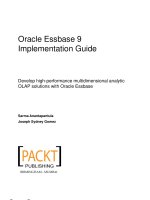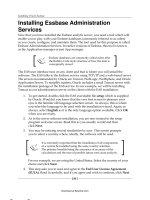Oracle Essbase 9 Implementation Guide- P16 ppt
Bạn đang xem bản rút gọn của tài liệu. Xem và tải ngay bản đầy đủ của tài liệu tại đây (668.38 KB, 5 trang )
Essbase Data and Design Considerations
[ 60 ]
Developer access can easily be controlled with standard access level settings and a
typical developer never needs access to more than the database he or she is working
on at that time. The database designer level provides the developer with unrestricted
access to the Application|Database you have created for the project. The database
designer will be able to modify the outline, create and run calculation scripts, and
create and run data loads using load rules. There is also an optional setting to allow
the database designer the ability to grant new user accesses and reset passwords on
the database(s) they have their designer privileges on.
In the previous screenshot, we see the sub-screen App/Db Access, which is a tabbed
screen selection reached from the Create User screen. As we mentioned earlier,
this is where you can quickly add broad developer access at the database level.
The options are few but sufcient for the type of user or developer you are granting
access for. We will discuss in more detail, specic user access control, including the
use of security lters, later in the book.
This material is copyright and is licensed for the sole use by Paul Corcorran on 5th July 2009
8601 ave. p #1, , lubbock, , 79423
Download at Boykma.Com
Chapter 2
[ 61 ]
Summary
We made it this far and your head hasn't exploded, has it? Thank goodness! Oracle
Essbase or for that matter, any OLAP or analytic application, seems to have a certain
aura or mystique about them. Some people automatically shy away, thinking they're
just beyond normal comprehension. This is just not true.
We're condent the information has been presented in a manner that allows you
to grasp the concepts of Oracle Essbase and OLAP. We're also condent that you
are beginning to think Oracle Essbase is no big deal and wondering what all the
fuss is about.
It probably seems like this chapter has own by. You have now built an Essbase
application to house your newly built Essbase database. You've been given a high
level view of some of the more important features and aspects of Essbase application
and database properties. You've also created users for your databases.
In the next chapter, we go all out. We build a complete Essbase database outline
for our Esscar Motor Company example, which we will use for the rest of this
book. Starting with the base outline Essbase automatically creates when you build
a database, we take you through adding data dimensions, adding data members
to the dimensions, determining data storage options, loading data, and much more.
A veritable cornucopia of Essbase database outline information awaits you!
This material is copyright and is licensed for the sole use by Paul Corcorran on 5th July 2009
8601 ave. p #1, , lubbock, , 79423
Download at Boykma.Com
This material is copyright and is licensed for the sole use by Paul Corcorran on 5th July 2009
8601 ave. p #1, , lubbock, , 79423
Download at Boykma.Com
Building the Essbase Outline
We know that any true technology geek gets impatient, at the very least, when
made to suffer through too much reading and page turning. We too feel the same
way, but it was absolutely necessary to give you everything we did in the previous
two chapters. Likewise, it is also necessary to give you every detail in this chapter.
You are aware of the fact that the Esscar Motor Company is hunting for a new
system to provide their production and sales planning department with the ability
to quickly create sales and production forecasts, prot forecasts, scenario over
scenario what-if analysis, and more.
Armed with what you have learned in the previous chapters and using the Oracle
Essbase Esscar application and database you created in Chapter 2, we will now
guide you through building an honest-to-goodness real and usable database outline.
We will show you how to build the dimensions necessary to describe the data using
a step-by-step approach. We will add members to the dimensions that organize and
store the data. We will also show you how to determine the best storage methods for
the data. Finally, we will show you the different ways to load the data.
If you haven't done so yet, we recommend getting yourself near to a PC that has
Essbase Administration Services (EAS) properly installed and connected to an active
Essbase server. You’ll want to perform the tasks we will be taking you through.
Before we begin
Before we get too deeply involved with the Essbase outline, we just wanted to be
clear that the information and examples presented in this chapter assume that you
have created your database using the BSO.
We devote most of the future chapter to explaining the BSO and the ASO options,
both their similarities and their differences.
So remember, the BSO is the avor of this chapter.
This material is copyright and is licensed for the sole use by Paul Corcorran on 5th July 2009
8601 ave. p #1, , lubbock, , 79423
Download at Boykma.Com
Building the Essbase Outline
[ 64 ]
The Essbase outline—the foundation
Think of the Essbase database outline as the air trafc controller of the database
or a planning and logistics manager or even a trafc cop. For those of you who are
relational database fans, you can think of an Essbase database outline as a logical
database model. It can be thought of as a tool that gives you a visual reference to
how the data is stored in the database and how the different elements relate to
each other. Think of the Essbase database outline as all of these things and more.
As the very foundation, the Essbase database outline is the framework or base
platform, upon which the entire database is built. If you remember, when you
created your rst Essbase database in the previous chapter, a shell or empty
Essbase database outline was automatically created.
This newly created shell outline has no dimensions or members, does not contain
any data, and is just a place holder or starting point. Let us now learn about the
various components and features that make up an Essbase database outline and
then build one!
Dimensions and members
We have previously discussed that the Essbase database outline is comprised of
components called dimensions and members. To quickly review, remember that
the outline dimensions are best described as the categories of your data that is,
model year, calendar periods, and so on. For you die-hard relational database types,
dimensions loosely translate into the columns you use in your tables. Database outline
members are the children of the dimensions. The database members and dimensions
enjoy a hierarchical parent-child relationship with the dimensions at the highest level.
Dimensions are best used to describe the data in the data warehouse system.
Dimensions are the top-most members in the hierarchy. A dimension can represent
the summarized or consolidated data for all its children members. In the following
screenshot TOTAL VEHICLE is the parent dimension.
Members are children of the parent dimensions. A parent dimension can have
an innite number of child members. The member can either store the data or
dynamically calculate the data upon request.
This material is copyright and is licensed for the sole use by Paul Corcorran on 5th July 2009
8601 ave. p #1, , lubbock, , 79423
Download at Boykma.Com









